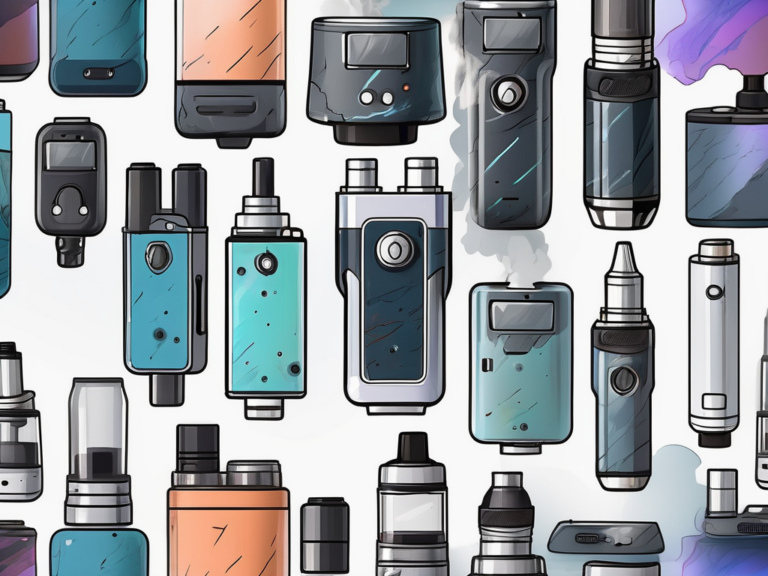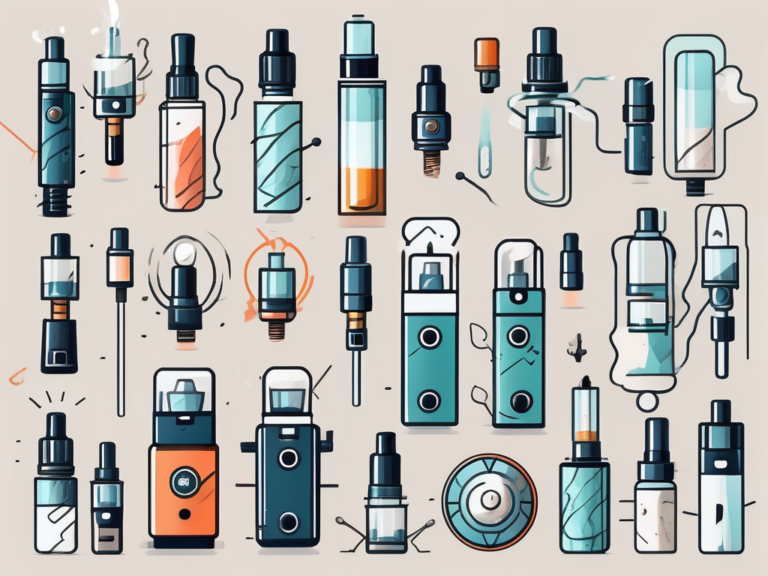why do vapes get clogged
Vaping has become a popular alternative to traditional smoking, offering a range of benefits such as reduced odor, customizable flavors, and potentially fewer harmful chemicals. However, like any electronic device, vapes can sometimes encounter issues, such as getting clogged. If you’ve ever experienced a clogged vape, you know how frustrating it can be. In this article, we will explore why vapes get clogged, the science behind it, common causes, and how to prevent and fix this issue.
Understanding the Anatomy of a Vape
Before delving into the reasons behind vape clogging, it’s essential to understand the various components that make up a vape device. Vapes consist of three main parts: the atomizer, vape tank, and mouthpiece.
Each component of a vape device plays a crucial role in delivering a smooth and enjoyable vaping experience. Understanding how these parts work together can help vapers troubleshoot common issues like clogging and improve the overall performance of their device.
The Role of the Atomizer
The atomizer serves as the heating element within the vape device. It vaporizes the e-liquid, allowing you to inhale the resulting vapor. The atomizer typically contains a coil, which can sometimes become clogged due to residue buildup or improper maintenance.
Regular cleaning and maintenance of the atomizer can help prevent clogging and ensure that your vape device continues to function optimally. Proper care of the coil, such as replacing it when necessary and avoiding overfilling the tank, can extend the lifespan of your atomizer and improve the quality of your vaping experience.
Importance of the Vape Tank
The vape tank holds the e-liquid and supplies it to the atomizer. It plays a crucial role in delivering a consistent vaping experience. If the tank becomes clogged, it can impede the flow of e-liquid, resulting in a clogged vape.
Choosing the right vape tank for your device and e-liquid preferences is essential for avoiding clogs and leaks. Properly maintaining the tank by cleaning it regularly and checking for any signs of damage can help prevent issues that may affect the performance of your vape.
Function of the Mouthpiece
The mouthpiece is the part of the vape device that you directly inhale from. While it may not be a common cause of clogging, residue buildup or improper cleaning can occasionally affect the mouthpiece’s functionality.
Ensuring that the mouthpiece is clean and free of any debris is important for maintaining good hygiene and preventing any unwanted flavors or particles from affecting your vaping experience. Some vapers prefer to customize their mouthpieces for comfort or style, but it’s essential to choose options that are compatible with your device to avoid any potential issues.
The Science Behind Vape Clogging
Understanding the underlying science behind why vapes get clogged can help you better prevent and fix this issue. Several factors contribute to vape clogging, including viscosity, temperature changes, and residue buildup.
Delving deeper into the intricacies of vape clogging reveals a fascinating interplay of various elements within the vaping device. The intricate design of the atomizer and vape tank plays a crucial role in determining how susceptible a vape is to clogging. The size and shape of the channels through which the e-liquid flows, as well as the materials used in the construction of these components, can all impact the likelihood of clogs forming.
The Impact of Viscosity
Viscosity refers to the thickness or stickiness of the e-liquid. Some e-liquids have higher viscosity levels, making them more prone to causing clogs. When the e-liquid is too thick, it may struggle to flow through the atomizer and vape tank, resulting in clogging.
Moreover, the composition of the e-liquid itself can vary widely, with different ratios of propylene glycol (PG) and vegetable glycerin (VG) affecting viscosity levels. Understanding how these components interact and influence the overall viscosity of the e-liquid can provide valuable insights into mitigating clogging issues.
Role of Temperature Changes
Vapes rely on heat to vaporize the e-liquid. Temperature fluctuations can affect the consistency of the e-liquid, potentially leading to clogs. Extreme temperature changes, such as leaving your vape in a hot car or exposing it to cold temperatures, can impact the e-liquid’s flow and cause clogging.
Furthermore, the impact of temperature on the physical properties of the e-liquid extends beyond viscosity. Changes in temperature can also alter the surface tension of the liquid, affecting how it interacts with the components of the vape device. This dynamic relationship underscores the importance of maintaining stable temperature conditions to prevent clogs.
The Effect of Residue Build-up
Over time, residue from the e-liquid can accumulate in the atomizer, vape tank, and mouthpiece. This residue can harden and clog the components, hindering the proper functioning of the vape device. Regular cleaning and maintenance are crucial in preventing this issue.
Moreover, the chemical composition of the e-liquid residue can undergo complex transformations when exposed to heat from the atomizer, further exacerbating the clogging problem. Understanding the chemical processes involved in residue formation and hardening can empower vapers to adopt effective cleaning strategies to maintain optimal performance of their devices.
Common Causes of Vape Clogging
Now that we understand the science behind vape clogging, let’s explore some common causes:
Improper Maintenance and Cleaning
Proper maintenance and cleaning are vital to prevent clogging. Failing to clean your vape regularly allows residue to build up and clog the device. Ensure you follow the manufacturer’s guidelines for cleaning and maintenance.
Regularly cleaning your vape not only prevents clogging but also ensures a better vaping experience. Residue buildup not only affects the airflow but can also alter the flavor of your e-liquid. By maintaining a clean device, you can prolong its lifespan and enjoy consistent vapor production.
Overfilling the Vape Tank
Overfilling the vape tank can lead to leaks and clogs. It’s essential to fill the tank to the recommended level to prevent e-liquid from overflowing into other components, causing blockages.
When filling your tank, be mindful of the maximum capacity to avoid any spillage or leakage. Overfilling not only creates a mess but can also seep into the device, leading to sticky residue that contributes to clogs. By following the recommended fill level, you can prevent these issues and maintain optimal performance.
Using the Wrong E-Liquid
Using an incompatible e-liquid can also result in clogs. Different vapes require specific e-liquids, and using the wrong type can lead to issues such as clogging and decreased performance. Always check the manufacturer’s recommendations for compatible e-liquids.
Choosing the right e-liquid is crucial for preventing clogs and ensuring a smooth vaping experience. Incompatible e-liquids can contain ingredients that are too thick or thin for your device, leading to blockages in the coils or wicking system. By selecting the appropriate e-liquid for your vape, you can avoid clogs and enjoy consistent vapor production.
Preventing and Fixing a Clogged Vape
While vape clogs are frustrating, there are steps you can take to prevent and fix them:
Regular Cleaning and Maintenance Tips
Regularly clean your vape device following the manufacturer’s instructions. This helps prevent residue buildup and ensures optimal performance. Additionally, consider using cleaning tools specifically designed for vapes to remove any clogs or residue.
Choosing the Right E-Liquid
Ensure you use the appropriate e-liquid for your vape device. Different vapes have specific requirements for viscosity and nicotine levels. Choosing the right e-liquid can minimize the risk of clogging.
Proper Usage and Handling of Vapes
Proper usage and handling of your vape device can also reduce the likelihood of clogs. Avoid exposing your vape to extreme temperatures and handle it with care. Additionally, avoid puffing too forcefully, as this can push excess e-liquid into the components, leading to clogs.
It’s important to note that the type of coil in your vape can also impact the likelihood of clogs. Coils with smaller openings or those designed for higher VG e-liquids may be more prone to clogging. Understanding your coil’s specifications and compatibility with different e-liquids can help prevent this issue.
Furthermore, the airflow settings on your vape device play a crucial role in preventing clogs. Adjusting the airflow to suit your vaping style can help maintain a smooth vaping experience. Too much restriction in the airflow can lead to e-liquid buildup and eventual clogs, while too much airflow may not vaporize the e-liquid efficiently.
In conclusion, understanding why vapes get clogged, the science behind it, common causes, and preventive measures are essential for a smooth vaping experience. By implementing proper cleaning and maintenance routines, using compatible e-liquids, handling your vape device correctly, paying attention to coil specifications, and adjusting airflow settings, you can minimize the risk of experiencing frustrating clogs. Enjoying the benefits of vaping while keeping your device in optimal condition is crucial for a satisfying experience.






